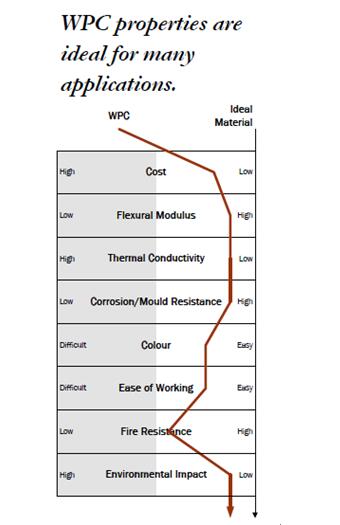WPC (Wood Plastic Composite) boards are fire resistant to a certain degree, but not completely fireproof. WPC boards are made from a mixture of wood fibers and plastic, and the wood component of WPCs is combustible. However, WPC boards are typically treated with fire retardants to reduce their flammability.
Fire Performance: WPC vs Traditional Wood
General experience shows that WPCs have a fire behavior very similar to, or better than that of comparable timber products.
Fire tests relate to either flammability or ignitability which considers the ease with which a material will catch fire and sustain burning and “spread of flame” which considers the propagation of fire by the material being tested.
Most of the fire testing of WPCs has been carried out ASTM standards in USA and EN standards in European. Their test methods are similar.
As a general rule, the presence of the plastic matrix appears to improve the fire performance of the wood component in WPCs. Many plastics, e.g. PVC-U, HDPE, etc. have good ignitability and spread of flame performance and this appears to be transferred to the WPC when they are used as the plastic component.
WPC boards show good results in ignitability tests and these are similar to the results for wood with similar density.
WPC boards show good results in spread of flame testing and the results can actually be better that those of wood with a similar density.

Enhancing Fire Performance of WPC Boards
Advanced Fire Protection Technologies
The performance of WPC board fire resistance can be modified and improved through the incorporation of flame and smoke retardants during the manufacturing process. These additives are introduced to the raw material before processing, with halogen-free fire retardants being particularly effective when mixed into the wood-polyme#2C5F2Dr mixture during the melt phase.
WPC Fire Rating Classifications
- Class A Rating: WPC boards typically do not achieve a Class A fire rating, which indicates the highest level of fire resistance. Most WPC products are more commonly classified as Class B or Class C. Select WPC manufacturers offer specialized fire-proof formula products that can achieve a Class A rating under the ASTM E84018 standard, highlighting the potential to deliver enhanced fire-resistance properties.
- Class B and C Ratings: Many WPC boards are categorized as Class B or Class C under various testing standards such as EN 13501-1 and ASTM E84. Class B indicates significant fire resistance suitable for commercial applications, while Class C provides moderate resistance appropriate for standard uses.
Safety Limitations and Implementation
It is important to note that no building material is completely fireproof. Even WPC boards with a Class A fire rating can ignite and burn if exposed to a high enough heat source. However, WPC boards with a Class A fire rating will resist fire for a longer period of time than WPC boards with a lower fire rating.
It’s essential to acknowledge that while WPCs generally exhibit commendable fire performance, the flammability factor remains significant in specific construction applications. Therefore, it is imperative to always implement appropriate fire safety measures when employing WPCs in construction projects.
For detailed insights and deeper understanding, refer to the following sources:
- SafetyLit: WPCs Fire Protection Kit
- U.S. Forest Service: Research on WPCs
Understanding the behavior of WPC board fire resistance allows for more informed decision-making in construction, ensuring both safety and optimal performance in diverse building applications.
Bongywood Wood Plastic Composite
Guangdong Bangying New Building Materials Co., Ltd. is a professional manufacturer specializing in the R&D, production, and sales of WPC (Wood Plastic Composite) materials, our products include composite decking, capped composite decking, WPC Wall Panel, WPC Railing & Fencing, WPC Pergola & Gazebo, WPC Chairs & Bench, WPC Flower Planter Pots, etc.
Leave a Reply






